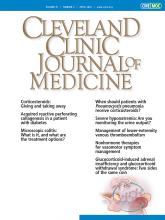Microscopic colitis, an inflammatory disorder characterized by chronic diarrhea, is so named because its diagnosis requires histologic evaluation with mucosal biopsy. It may be overlooked as a cause of chronic diarrhea because cross-sectional imaging and endoscopic evaluation are usually normal in the absence of a microscopic evaluation. A standard approach to therapy improves symptoms and quality of life.
DIAGNOSTIC CONSIDERATIONS
Microscopic colitis has 2 subtypes: the collagenous subtype features the development of a subepithelial collagen band, and the lymphocytic subtype is characterized by intraepithelial lymphocytosis.1
The quintessential clinical presentation, regardless of the subtype, is chronic, nonbloody, watery diarrhea with concomitant urgency, abdominal pain, and weight loss. Likely causes are multifactorial and include the following:
Alteration of gut microbiota, or dysbiosis2
Immune system dysregulation
Medications such as proton pump inhibitors, selective serotonin reuptake inhibitors, nonsteroidal anti-inflammatory drugs, and checkpoint inhibitors2,3
Bile acid malabsorption
Smoking
Genetic susceptibility, with protective human leukocyte antigen loci implicated.2
Because the clinical presentation of microscopic colitis often overlaps with other diagnoses such as celiac disease and irritable bowel syndrome, competing diagnoses should be excluded.2 The diagnosis of microscopic colitis can be confirmed with colonoscopy with biopsy of the ascending and descending colon.
Despite the inflammatory nature of microscopic colitis, there is little benefit to obtaining C-reactive protein and erythrocyte sedimentation rate values, as neither is elevated in most cases of microscopic colitis.4
A recent meta-analysis determined the worldwide incidence of microscopic colitis to be about 5 per 100,000 patient-years, with a female predominance.2 Although microscopic colitis occurs at all ages, it is more common in patients older than 60.
TREATMENT: BUDESONIDE FOR INDUCTION AND MAINTENANCE OF CLINICAL REMISSION
First-line therapy for microscopic colitis, regardless of the subtype, is budesonide 9 mg/day for 8 weeks.5 If the patient is symptom-free after 8 weeks, budesonide therapy can be stopped. If the patient remains symptomatic at the end of 8 weeks or if symptoms recur, then budesonide can be continued or resumed at the lowest effective dose, usually 6 mg/day or less, for 6 to 12 months.2
Patients should be advised to avoid smoking and using nonsteroidal anti-inflammatory drugs. If possible, they should discontinue all associated medications, including proton pump inhibitors, statins, aspirin, immune checkpoint inhibitors, and selective serotonin reuptake inhibitors.3
Alternative therapies
When budesonide therapy is unfeasible or ineffective, other treatment options include secondary medications such as the bile acid sequestrant cholestyramine, loperamide, or bismuth salicylate, all with varying degrees of efficacy.4,5 Some authors note that starting loperamide with budesonide might augment symptomatic relief, but few studies suggest that this combination is superior to budesonide alone.4,5
Some evidence supports the use of immunomodulators, including azathioprine and mercaptopurine, in the treatment of microscopic colitis.2,6 Biologic therapies such as antitumor necrosis factor agents infliximab or adalimumab or the anti-integrin antibody agent vedolizumab have shown some success.2 Data are emerging regarding Janus kinase inhibitors for treating microscopic colitis, but to date their efficacy is uncertain.2 Mesalamine compounds have not proven effective. The American Gastroenterological Association Institute guideline5 recommends mesalamine as a potential alternative to budesonide, but the European guidelines7 do not.
Studies of probiotics have also generated little evidence to support their use in mitigating microscopic colitis.5 The Institute guideline and other authors recommend against the use of probiotics for microscopic colitis.4,5
DISEASE COURSE
With effective treatment, symptoms and quality of life improve with microscopic colitis. Predictions of sustained remission vary widely among studies.1 Although remission occurs for many patients, in most, the typical disease course is chronic or relapsing.8
As a general rule, continued budesonide therapy may be indicated for patients who are not in remission after 6 to 12 months.8 Unlike ulcerative colitis and Crohn disease, which carry a longitudinal risk of colorectal cancer, microscopic colitis carries no such increased risk. The goal of continued treatment is clinical (ie, symptomatic) remission.
DISCLOSURES
The authors report no relevant financial relationships which, in the context of their contributions, could be perceived as a potential conflict of interest.
- Copyright © 2024 The Cleveland Clinic Foundation. All Rights Reserved.






